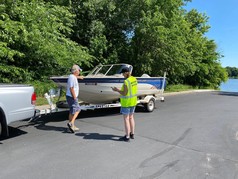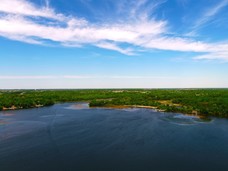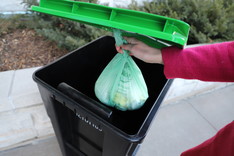|
Hennepin County receives funding from the State of Minnesota to prevent the spread of aquatic invasive species such as zebra mussels and Eurasian watermilfoil. The county awards a portion of this funding as grants to help local units of government and organizations implement projects that prevent the spread of aquatic invasive species. The following are a few of the projects underway this summer. For more information, contact Tony Brough at tony.brough@hennepin.us.
Randomized inspections and boater education

Hennepin County with staff from WaterGuards LLC is providing randomized inspections and boater education throughout the county. Inspectors will be present at times and locations where they have not typically been present before. The main focus is on educating boaters about the simple steps they should take to prevent the spread of aquatic invasive species while also tracking compliance rates.
The correct actions you need to take depend on your specific watercraft and how long you are on a lake. For typical day users, simple steps include taking a close look and removing vegetation from your trailer and boat, draining and drying all water from the live well and bilge, and disposing of bait correctly. There are different steps to take if your watercraft is in a body of water for longer than 24 hours and if you have a ballast tank, such as those found in wakeboard boats. Find complete guidelines from the Minnesota Department of Natural Resources.
Public access users should feel free to talk to an inspector to understand your specific requirements. They are there for you and to help protect our lakes!
Aerial early detection pilot on Medicine Lake
|

Hennepin County, in partnership with Hughes Company Innovations, is conducting an innovative project for early detection of aquatic invasive species using an industrial drone. The drone, equipped with high-resolution optical and multispectral sensors, is mapping approximately 50 acres on Medicine Lake.
This area is known to have three aquatic invasive species, including Starry Stonewort. Starry Stonewort has only been found in 14 water bodies in Minnesota and was first discovered in Medicine Lake in 2018. This project is looking to see if this technology can be used for improvements with early detection, rapid response, and management of aquatic invasive species throughout the county and Minnesota. The initial flight occurred May 27 and 28, and the preliminary results are encouraging!
Aquatic invasive species prevention efforts at Lake Minnetonka featured on Due North Outdoors
|
Due North Outdoors, an outdoor living show on Fox Sports, recently featured some of the county’s efforts to prevent the spread of aquatic invasive species on Lake Minnetonka. The county has partnered with CD3 to install boat cleaning stations at public accesses. The stations prompt boaters of the steps they need to take and provide them the tools to take action. The county has also installed electronic messaging boards at public accesses and bridges to raise awareness about aquatic invasive species as well as share public safety messaging.


Fix-It Clinics offer free, guided assistance from volunteers with repair skills to disassemble, troubleshoot, and (hopefully) fix small household appliances, clothing, electronics, mobile devices and more. While we look forward to holding in-person Fix-It Clinics again when possible, one-on-one virtual repair sessions with Fix-It Clinic volunteers are now available.
To get assistance, complete the virtual repair assistance intake form. The form gathers basic information about the item in need of repair. Once your form has been reviewed, you will be connected with a volunteer via email, and then you will set up a time to meet virtually.
You will need a laptop, tablet or phone and Internet connection that allows for video conferencing. You will likely need some common tools such as screwdrivers, pliers, and a flashlight. It's helpful to have a second person in your household helping you aim the camera and assisting with disassembly and repairs.
For more information, contact Nancy Lo at nancy.lo@hennepin.us.
|

Organics recycling carts are being delivered to every household in Edina, giving residents the opportunity to put their food scraps, food-soiled paper, and compostable products to better use as compost.
About 30% of what we put in the trash is food and other organic materials, making organics recycling the best opportunity to reduce our trash and achieve our recycling goals. The materials collected in organics recycling programs are delivered to a commercial composting facility, where they are recycled into a nutrient-rich soil amendment that is used in gardens and landscaping projects. Diverting organics from the trash also reduces emissions of greenhouse gases, especially methane, which is generated from the decomposition of organic materials in landfills.
Hennepin County is requiring that all cities in the county offer organics recycling service to residents by 2022. In an effort to increase participation, Edina took a new approach by delivering an organics recycling cart to every household rather than having participants sign up. Edina has already seen residents eagerly starting to participate and others stepping up to be a resource for neighbors as they learn about the new program.
|
Resources for starting organics recycling

Permanently protect your land, preserve what you value, and leave a conservation legacy

Hennepin County is working to protect the last best remaining natural areas in the county, and partnering with landowners to permanently protect their land is an important part of reaching that goal.
Landowners can be compensated for permanently protecting their property with a conservation easement, which is a set of development restrictions that a landowner voluntarily places on their property to protect its natural resources. Funding is also available for habitat restoration projects on permanently protected properties.
Submit your interest by applying by July 17
Hennepin County is gathering interest from landowners who want to explore the opportunity of establishing a conservation easement. Applications for the next round of projects are due July 17.
Conservation easements are one of the most effective tools for permanently protecting natural areas on private property. They allow landowners to protect what they value about their land, whether that be the open space, views, rural character, wildlife habitat, mature forest, and more.
If you or someone you know is interested in learning more about the Hennepin County habitat conservation program or want to apply for conservation easement funding, fill out the online interest form or contact Kristine Maurer at kristine.maurer@hennepin.us or 612-348-6570.
|
ReUSE Minnesota national virtual conference
Join ReUSE Minnesota's national virtual conference - ReUSE2020: Vision for a Circular Future on Monday, July 13 from 12:30 to 4 p.m. and Tuesday, July 14 from 10 a.m. to 1:30 p.m.

ReUSE2020: Vision for a Circular Future will showcase speakers and panelists exploring how reuse, rental, and repair play an essential role in supporting and stabilizing sustainable communities. Now more than ever, we’re witnessing the limitations of our existing supply chains and the harmful impacts of our consumption patterns. It’s time to move from the linear status quo to a circular, regenerative model.
While a virtual conference wasn’t the original plan, ReUSE Minnesota is excited to bring an interactive and energizing learning and networking experience to you! Two Hennepin County waste reduction and recycling specialists will be speaking during the conference. Olivia Cashman will present on the county's deconstruction program, and Amy Maas will present on the Hennepin County Zero Waste Challenge.
Register online today!

Thrift shopping is a great way to find quality clothing, shoes, accessories, household items, toys, furniture and more at well below retail prices
Beyond just great savings and fun finds, buying used instead of new helps the environment by reducing the amount of trash we produce and preserving the natural resources that go into manufacturing, packaging, transporting and ultimately disposing of new goods.
Despite the savings to your wallet and the world, some shoppers still hesitate to embrace thrifting. If you’re new to thrift shopping, these five insights will help you get started.
|
-
Finding current fashions: Thrift stores want to sell their clothing and other items, so they carry what they know customers want. Expect to find an intriguing mix of current, vintage, and unique styles.
-
Looking beyond clothes: Most thrift stores carry a wide selection of goods, including wooden furniture, books, vinyl records, bikes, kitchen gadgets and appliances, picture frames, and tools.
-
Finding what you’re looking for: Know what you’re looking for and browse the store, scanning for pieces that catch your eye. It can help to ask thrift store staff about what they carry and what you’re seeking.
-
Washing thrift store clothes: Although items are typically washed before being donated, it’s always a good idea to wash clothing you get at a thrift store before wearing it. Just like when buying new items, many people have likely touched that item before you bring it home. Similarly, you should wash cookware and dishes and wipe down kids' toys, electronics, and furniture before using.
-
Enjoying numerous benefits: When you buy used, you save money and help protect the environment. Thrift stores also have a constantly changing selection of items, so you can find unique items, rare vintage finds, and designer brands.
Learn more by reading 9 frequently asked questions for smart, smart and savvy thrift shopping on our Choose to Reuse website and sign up to Join the Circle and get more tips on buying used.
|